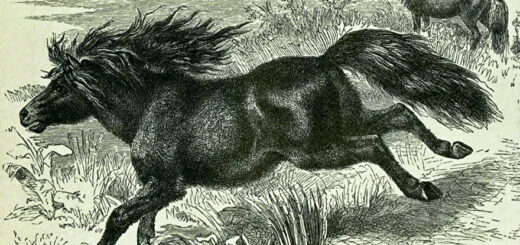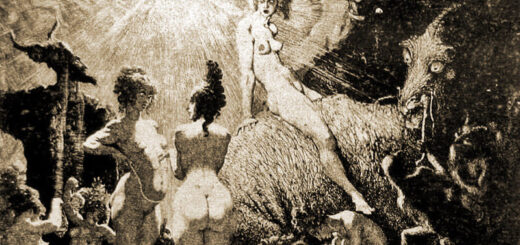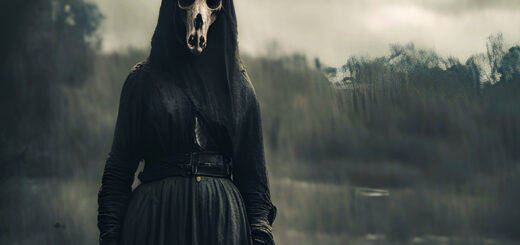Poltergeist
A poltergeist, from the German Poltergeist, derived from poltern “making noise” and geist “mind”, is a paranormal phenomenon consisting of various noises, displacements, apparitions or disappearances of objects and other phenomena a priori inexplicable. In general, they are considered as “small haunting” phenomena that would be related to the presence of a disturbed adolescent, as opposed to “large haunting” phenomena that involve the intervention of the spirit(s) of one or more dead, although the distinction is not always obvious. In the French Vallée Classification System, poltergeists fall into the category of “physical effect anomalies” or AN type II.
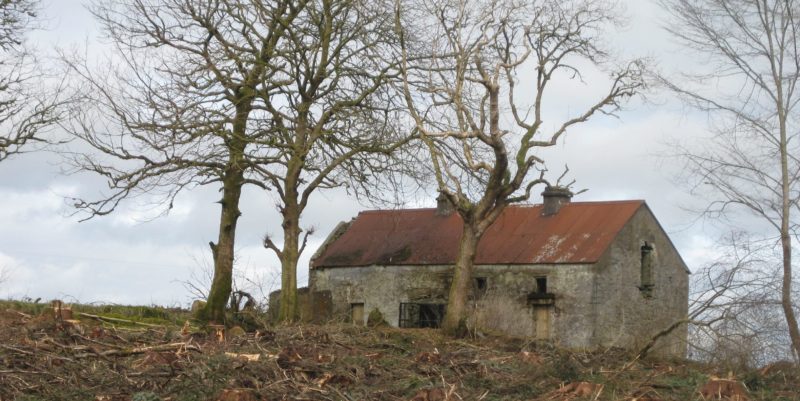
In the area of Cooneen, near the Fermanagh – Tyrone border sits an isolated, abandoned cottage. In 1911 this was the home of the Murphy family, who were apparently victims of poltergeist activity. Mrs Murphy was a widow who, along with her children, began to hear mysterious noises at night: knocks on the door, footsteps in the empty loft and unexplained creaks and groans.
The term poltergeist appeared in 1540 in the Novum Dictionarii genus (New Dictionary) of Erasmus Alberus. It is used, for the first time in German, by Martin Luther during the Protestant Reformation to designate events that would be caused by disembodied spirits or by the devil. Catherine Crowe first used it in English in 1848 and it was the Romanian medium Eleonore Zugun who, in the middle of the 20th century, popularized it by calling herself “Poltergeist’s daughter “. Paradoxically, the Germans are now more willing to use the term Spuk.
Nature of the phenomenon
The manifestations of a poltergeist present all or part of a considerable range of effects defying reason: violent blows or noises of percussion, various noises, without any identifiable cause; unexplained throwing of stones or debris, targeting the inside or outside of a house (lithobolia); displacement or projection of objects (sometimes broken), up to their levitation or apparent teleportation through solid walls. More rarely: spontaneous combustion; actions on people: contacts, scratches, bites and levitations, use of a spectral voice (use of victims’ “false vocal cords”) and appearances. Here is Ernest Bozzano’s description of it in Les Phénomènes de hantise:
“In addition to the phenomena to which we have referred, moving furniture, slamming windows and doors, breaking dishes, these are very often doorbells that keep shaking loudly for no apparent reason, even after they have been isolated by the removal of cords and wires. Equally frequent are cases of “stone rains”, with very remarkable characteristic features, such as when the stones travel trajectories contrary to physical laws, or stop in the air, or fall slowly, or reach a determined goal with very unusual dexterity, or strike without harming, or then bounce back, as if they were grabbed by an invisible hand; also the the stones can be hot, or even burning. In other circumstances, the sheets are violently ripped off the beds of the people lying down, the latter being lifted and gently placed on the floor, if however the beds themselves are not knocked over.
The demonstrations generally seem to be purely “free” and totally devoid of cause and logic. Despite material damage, sometimes significant, the people present are rarely injured:
“But what surprised us most was that none of the 300 stones thrown touched anyone; on the first day, my little boy was in the garden, my little girl was sleeping on the first floor, in her crib near the open window; they were not inconvenienced in any way; the maid received, it is true, a quarter of a brick on her head, but she hardly suffered at all; my father-in-law was touched in the arm and he shouted, “Look, I didn’t feel anything”.
The phenomenon is reported in all regions of the world, in Europe and the United States, but also in China, Africa, South America, Japan, India, New Zealand, Patagonia, the West Indies, Java, etc. It is also present at all times: the researcher Hereward Carrington identified five of them before the year 1000, and 130 between the 16th century and the end of the 19th century. However, a study concerning the phenomena “psi” in antiquity finds “no recognizable pre-Christian narrative” describing a poltergeist, although Suetonius cites the case of a man who, having fallen asleep in a sacred place, suddenly found himself ejected, with his bed, “by a sudden occult force”.

Sometimes poltergeist make things really go out of hand.
Legend or reality?
In the case of so-called paranormal or supernatural phenomena, many testimonies are often the result of excessive imagination on the part of witnesses, or even psychological disorders. In the case of “striking spirits”, these are, in most cases, natural noises from the “work” of carpentry or masonry, the passage of small animals or the noise of underground watercourses. In addition, of course, there are deliberate deceptions, jokes in bad taste and acts of malice.
According to Professor Charles Richet in Traité de Métapsychique:
“But for objective phenomena, the difficulty is different. There indeed all frauds are possible, and experience has shown that frauds are frequent, very frequent. When, in a so-called haunted house, there are various clashes, noises of doors opening and closing, furniture rolling, dishes breaking, and all the ridiculous procession of demonstrations that is customary in hauntings, the idea comes first of all that it is a strong joke, made by malicious individuals, dismissed servants, people interested in making this or that of its inhabitants leave the house. More often than not, the cause of these infestations must be blamed on very young people, of either sex, half stupid, half vicious, who, without really understanding what they are doing, throw stones, break windows, hiding their actions and suggesting that they have remained motionless, having no other reason than to deceive.”
However, there remains a large number of testimonies, from all periods and in all cultures, which tend to demonstrate that unexplained phenomena occur episodically, observed by reliable witnesses and sometimes giving rise to very official gendarmerie reports or in-depth investigations, possibly accompanied by physical records or photographs.
As Pascale Catala notes in Apparitions et hantises:
“In the cases they investigated, parapsychologists often found that subjects simulated poltergeists by causing damage themselves (breaking or knocking over objects, throwing stones, etc.). Alan Gauld identified “frauds” in 12% of cases, and Hans Bender in 26%, even in cases where paranormal events had been identified. It is therefore advisable to remain very cautious and to adopt a nuanced attitude: just because a subject cheats or simulates, it is not necessarily a question of a false poltergeist. Tizané pointed out that the gendarmes often caught a subject in the act, and decreed that the case was solved, whereas it was not, some phenomena remaining totally unexplained. ”
Dr. Maxwell had, at one time, made remarks along the same lines in Bulletin de l’Institut Général Psychologique:
“We do not know what causes can lead some people to commit fraud: in most cases, there is no interest to guide them; the origin of the demonstrations cannot be explained; we do not understand how ten- or twelve-year-old girls came up with the idea of throwing stones, breaking windows or having chairs dance and stealing plates. On the contrary, the explanation of their conduct becomes easy, if we assume that real phenomena preceded the imitation made by the young subject and suggested the idea. We would be dealing with these cases of mixed fraud, where some truths are mixed with lies, cases frequently observed in professional sleepwalking or spiritualism subjects.”
Folklore and popular belief
In Western popular belief, especially in the USA and Europe, poltergeists are often seen as the souls of deceased people who died or were killed in a sudden, mostly violent death. Today Hollywood is mainly responsible for that association. In European folklore poltergeist phenomena were often attributed to the activities of elves, goblins and related fairies or household spirits. In Japan and China, poltergeist activities are attributed to certain demons such as the Bakeneko, Nekomata, and Rokurokubi. Due to the violence and destructiveness associated with poltergeist activities, poltergeists are always perceived and classified as malignant. Poltergeists are also known in some regions as “Neckgeist” or “Klopfgeist” (“Klopgeest” in Dutch).
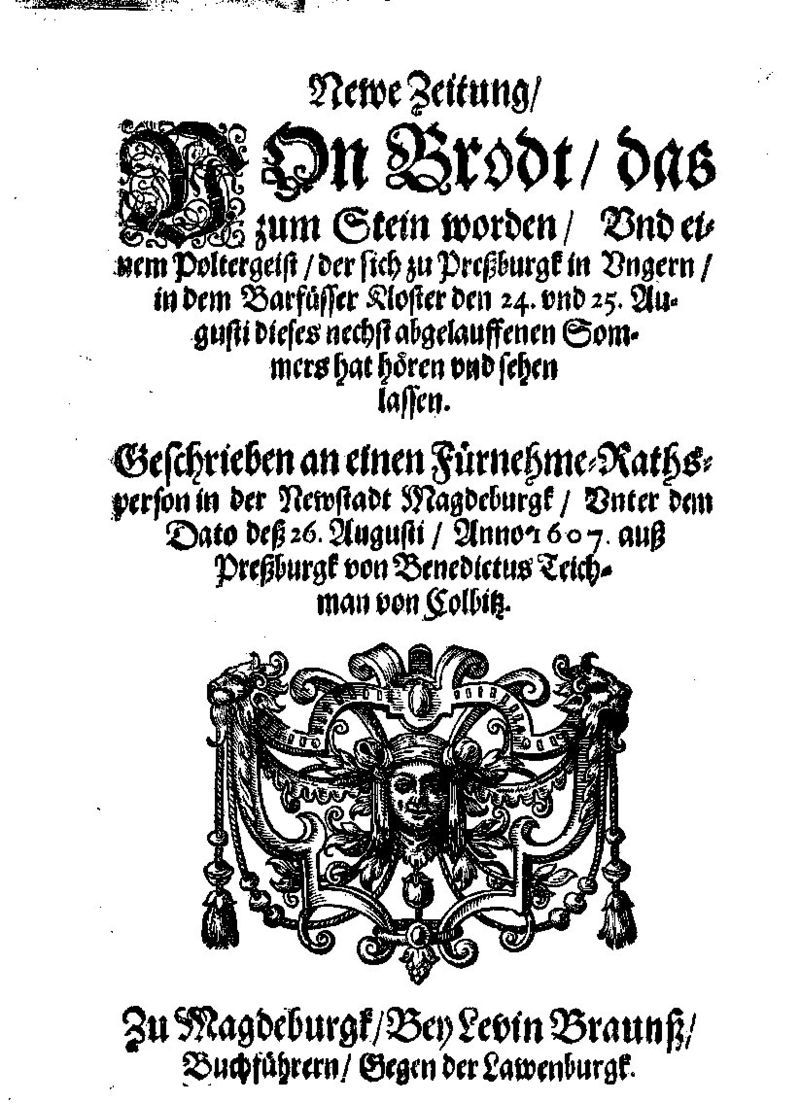
Von Brodt das zum Stein worden und einem Poltergeißt der Sich zu Preßburgt in Ungarn in dem Barfüsser Kloßter den 24. und 25. August dieses nechßt abgelauffenen Sommers hat hören und sehen lassen, 1607
Historical Poltergeist cases
Reports about poltergeists and their activities can be found in all known cultures and epochs. For example, the Roman consul Pliny the Younger (around 100 A.D.) reported about a house of spirits in Greece that attracted his attention.
With the completion of the Reformation within the Church in the early 17th century and the division into the Roman Catholic and Protestant Churches, a fierce battle of faith began for various theological views and doctrines, including those concerned with life after death.
In the following, some better known cases of poltergeist will be presented.
Stone throwing poltergeis of Joigny (France) early 16th century
“The chronicler monk Raoul Glaber writes: “At the same time, a wonderful omen worthy of finding a place here appeared near the castle of Joigny, in the home of a noble man named Arlebaud. For three years, stones of various sizes fell almost continuously throughout his house, from which heaps can still be seen all around it. Did they come from the air, or did they penetrate through the roof? That’s what no one can say. What is certain is that this rain, which did not stop at night or during the day, did not hurt a single person, and did not even break a vase.” The French astronomer and researcher of paranormal phenomena Camille Flammarion (26 februari 1842 – 3 juni 1925) collected many detailed descriptions, mostly official police reports, of poltergeist cases in one of his last works: Les Maisons hantées (Haunted houses) of 1923 . Stone throwing poltergeist are not rare among them.
Glenluce Devil
In his book Satan’s Invisible Works Discovered (1685), Sinclair described an alleged poltergeist incident known as the Devil of Glenluce. Sinclair described the incident as having a “usefulness for refuting atheism.”
The incident is described as having taken place at the house of weaver Gilbert Campbell in Glenluce during October, 1654. A beggar Alexander Agnew was refused a handout by Campbell. Agnew had promised to cause the family harm and over the next two years strange phenomena were alleged to have occurred at the house. This included the mysterious cutting of warp thread, demonic voices, strange whistling noises and stones being thrown. The poltergeist claims have been dismissed by researchers as a hoax. Magic historian Thomas Frost suggested that the phenomena was the result of conjuring trickery. The story was given to Sinclair by Campbell’s son Thomas, a philosophy student from a college in Glasgow who was living at the household. Folklorist Andrew Lang suggested that Thomas had produced the phenomena fraudulently.
Historian David Damrosch has noted that Alexander Agnew commonly called the “Jock of Broad Scotland” was the first person in Scottish history to publicly deny the existence of God. He was hanged at Dumfries for blasphemy on May 21, 1656.
The Drummer of Tedworth
The Drummer of Tedworth is a case of an alleged poltergeist manifestation in the West Country of England by Joseph Glanvill, from his book Saducismus Triumphatus (1681).
Early accounts reported that in 1661 a local landowner, John Mompesson, owner of a house in the town of Tedworth (now called Tidworth, in Wiltshire), had brought a lawsuit against an unlicensed vagrant drummer William Drury, whom he accused of collecting money by false pretences. After he had won judgment against the drummer, the drum was turned over to Mompesson by the local bailiff. Mompesson then found his house plagued by nocturnal drumming noises. It was alleged that the drummer had brought these plagues of noise upon Mompesson’s head by witchcraft. Drury was said to have been associated with a band of gypsies.
Glanvill, who visited the house in 1663, had claimed to have heard strange scratching noises under a bed in the children’s room. On Christmas Day 1667, Samuel Pepys, in his diary, records his wife, Elizabeth, reading the story to him. He found it to be ‘a strange story of spirits and worth reading indeed’. In 1668, Glanvill published one of the earlier versions of Saducismus Triumphatus, his A Blow at Modern Sadducism … To which is added, The Relation of the Fam’d Disturbance by the Drummer, in the House of Mr. John Mompesson.
The “Mackie poltergeist”
According to a pamphlet first published by local minister Alexander Telfair in 1696, a farm called The Ring-Croft of Stocking inhabited by the family of stonemason and farmer Andrew MacKie was the site of mysterious occurrences such as stones being thrown, cattle being moved, buildings set on fire, voices heard, family members beaten and dragged, and notes found written in blood. Telfair wrote that neighbours were hit by rocks and beaten by staves, and that he had seen and felt a ghostly arm which quickly vanished. In the pamphlet, Telfair described things he had considered “to have been the occasion of the Trouble”, including MacKie supposedly taking an oath to devote his first child to the Devil, clothes left in the house by a “woman of ill repute”, and failure to burn a tooth buried under the threshold stone by a previous tenant advised by a spey-wife. According to the story, after Telfair and several other clergymen said prayers at the farm, the trouble eventually subsided.
Telfair’s pamphlet, entitled “A TRUE RELATION OF AN Apparition, Expressions and Actings, OF A SPIRIT, Which Infested the House of Andrew Mackie in Ring-Croft of Stocking, in the Paroch of Rerrick, in the Stewartry of Kirkcudbright, in Scotland. By Mr. Alexander Telfair, Minister of that Paroch: and Attested by many other Persons, who were also Eye and Ear-Witnesses“, was published by an Edinburgh printer in 1696 and sold at the shop of George Mosman. Telfair’s account ascribed the activity to a “violent noisy spirit”, and in later years the tale became known as the “Mackie poltergeist”, the “Ringcroft poltergeist”, or the “Rerrick (or Rerwick) poltergeist”.
The October 4, 1890 issue of the Saturday Review dismissed Telfair’s story as folklore and “a curious mixture of obvious naked imposture”, saying, “Five ministers, a few lairds, and a number of farmers signed this account, in which there is not a single suspicion breathed that the business was merely a practical joke. Mr. Telfair recites it as an argument against atheism, and for other reasons of edification.”
Sacheverell Sitwell in his book Poltergeists (1940) wrote that events described in the story were created by one of Mackie’s children using ventriloquism. Sitwell observes that a voice awoke MacKie, telling him he would “be troubled till Tuesday” and that if Scotland did not “repent” it would “trouble every family in the land”. According to Sitwell, “Here, again there can be no doubt whatever that the actual Poltergeist was one of the children of the family. It had, in fact, learnt to ventriloquise. This, though, does not make the mystery any less unpleasant”.
Academics, such as historians Lizanne Henderson and Ole Grell, wrote that Telfair’s pamphlet was intended to communicate to a “less sophisticated audience” and counteract what was felt among clergymen of the period to be the dangerous influences of skepticism, atheism and deism. Henderson and Grell note Telfair’s pamphlet’s stated purpose to disprove “the prevailing Spirit of Atheism and Infidelity in our time, denying both in Opinion and Practice the Existence of Spirits, either of God or Devils; and consequently a Heaven and Hell…”
Ring-Croft of Stocking, described as “a smallholding on the topside of Auchencairn”, was located in the parish of Rerrick. Reportedly, a dead tree is all that remains of the MacKie farm today.
Ghost of Cock Lane
In 1762, scratches and blows were heard in an apartment at 20 Cock Lane Street in London, accompanied by ghostly appearances. The case made headlines and even provoked religious controversy between the Methodist and Anglican churches. Finally, a commission appointed by the mayor of London concluded that there was a fraud involved. Several surveys confirm this opinion and a trial sentences the five protagonists of the fraud to various penalties.
Paris (France) 1846
In November 1846, a house located on the edge of the work on what would become rue Racine in Paris was bombarded every evening by stones of all sizes that smashed down doors, windows, roofs and floors. The resident, Mr. Lerrible, filed 30 complaints with the police. Officers are placed under surveillance, the police commissioner and even the chief of security go to the site. A platoon of the 24th fighter regiment was even sent to the scene, with no results. All the newspapers of the time reported the case, starting with the Gazette des Tribunaux. After three weeks the phenomenon stopped as abruptly as it had begun. It was claimed, without further clarification, that a man had been caught in the act and imprisoned. The newspaper La Patrie having published that the culprit was Mr. Lerrible himself, he sued the newspaper for defamation and won his trial. During the debates, there was no mention of the arrest of a real culprit. When questioned by a researcher, the answer of the police commissioner’s replacement was unambiguous:
“The police commissioner would tell you as I would, sir, that despite our tireless research, we have never been able to discover anything, and I can assure you in advance that we will never discover anything!” – Ernest Bozzano, Les Phénomènes de hantise (The Phenomena of Haunting)
La Roche-en-Brenil (France), 1898
In La Roche-en-Brenil, from 19 March 1898, a phenomenon occurred in the house of the weaver Louis Garrier. Tables and chairs tumble, beds move, dishes stored in different places jump on all sides and shatter. Plates stored in a boiler full of water jumped up one metre and escape from their containers. Milk jars were spilled and their contents flew onto the tiles; one of these jars was transported to a nearby chamber without being knocked over. The stove’s plugs, washers and doors escaped through the window, breaking all the windows, and fell into the street. A large massive table was tumbled.
This phenomenon drew a lot of attention. The parish priest excluded any supposition of deceit or farce. The cause of the phenomenon was finally attributed to an 11-year-old child of the l’Assistance publique de la Seine who was living with his family. After about ten days of disruption, the child is taken to the Saulieu Assistance depot and the phenomenon stops.
Arcachon (France) 1963
The clinic of Doctor Cuénot in Arcachon was bombarded with stones from May to September 1963, without any rational explanation. Projectiles of all kinds and sizes fall around staff and patients. The local police commissioner does not consider it necessary to conduct an investigation. Professor Robert Tocquet, called in as a reinforcement, concludes after a meticulous study that this rain of stones is linked to the presence of a young neurotic patient. It can under no circumstances be held responsible for the launching of projectiles, but the phenomenon stops after its transfer to another clinic.
Rosenheim (Germany) 1968

Rosenheim poltergeist
In November 1967, many phenomena of an electrical nature, but also unexplainable movements of furniture and objects, began to occur in the office of Sigmund Adam, a well-known lawyer in the city of Rosenheim near Munich: office machines went wrong, circuit breakers jumped, light bulbs roasted or unscrewed alone and fell, fluorescent tubes turned in their homes, ceiling lights swung until they touched the ceiling, etc. Phones ring for no reason, there are repeated calls – sometimes several per minute – to the talking clock. Obviously, it is the electricity grid that is first suspected. Voltage and current recorders are installed by the electricity distribution company, which sends two engineers to the site. The recordings show considerable variations in the measured values. The phenomena are taking place in the presence of the two specialists, municipal controllers and other witnesses. In an attempt to find a solution, a direct power supply line was connected to the transformer of the power grid. It is in turn replaced by a backup generator set without the anomalies ceasing.
The strange things are not exclusively of an electrical nature: from December 1967 onwards, unexplainable events multiplied: paintings were unhooked or turned upside down (the scene was filmed), twice a document cabinet weighing more than 150 kg was lifted 30 cm from the partition and it took two men to put it back in its place. Physics professor W. Büchel sees drawers coming out of their furniture alone. It is estimated that at least forty people from all walks of life witnessed these events.
Dr. F. Karger and physicist G. Zicha of the Max-Planck Institute for Physics in Munich were dispatched to the site and, after a long and thorough investigation, concluded that the phenomena, duly observed and recorded, could not be explained by the current means of theoretical physics. The conclusions of the official 19-page report written by the two experts are as follows:
Although they were recorded with all the facilities offered by experimental physics, the events defied any explanation by the usual physical theories.
The phenomena appeared to result from non-periodic forces of short duration.
They did not appear to be caused by known electrodynamic forces.
These were not only explosions, but also complex movements (rotations of tables, curves described by recording pens).
These movements gave the impression of being under intelligent control and tending to escape research.
In an attempt to clarify the mystery, the lawyer lodged a complaint against X and contacted the Institut für Grenzgebiete der Psychologie und Psychohygiene (IGPP) in Freiburg, chaired by Professor Hans Bender, a private institute conducting research in parapsychology. IGPP investigators note that, on the one hand, the phenomena only occur during office hours and, on the other hand, they increase in intensity when a young 19-year-old employee named Anne-Marie Schneider enters the company. It is at the moment of its passage in the corridors that the ceiling lights swing and the bulbs burst. When in mid-January 1968 a job was found for Anne-Marie in another study, with a formal prohibition by her new employer to talk about what had happened, the phenomena immediately stopped at Me Adam. They then occur at her new workplace and in her family, but briefly and in a reduced form.
Although the specialists and experts present on the spot did not find any explanation for the phenomena duly recorded, an attempt at a rational explanation, involving defective halogen tubes, was belatedly put forward. The hypothesis of an electromagnetic artifact, in addition to not explaining the movement of heavy objects, was disproved in 1976 in an article by Professor W. Büchel, who recalled that criticism must be based on rigorous demonstrations
Enfield (England) 1977
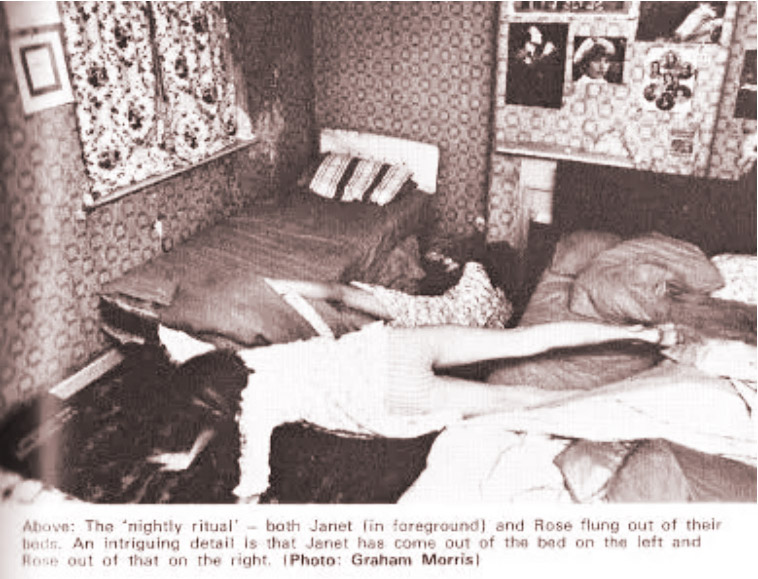
A spectacular poltergeist phenomenon took place in Enfield, in the northern suburbs of London, and was widely reported in the press at the time. It was declared “The most interesting poltergeist ever known”. The Harper family consists of a divorced mother and her four children: Margaret 13 years old, Janet 11 years old, Johnny 10 years old and Billy 7 years old. From August 31, 1977, the house was the site of an incredible festival of more than 1,500 demonstrations: objects and furniture spilled or moving alone, bed sheets lifted, Janet levitated, various noises and voices, dog barking, appearances, objects that seemed to cross the walls, fires starting in drawers, deformed objects… These facts were followed continuously for 13 months by two RPD investigators, Maurice Grosse and Guy Lyon Playfair. Some 30 people were direct witnesses, including police officers, BBC and Daily Mirror journalists, neighbours and various personalities. Despite Janet’s subsequent admission of a few fraud attempts to test the investigators (who have spotted them), most of the phenomena seem unlikely to have been artificially caused. Voices and noises are recorded and confusing scenes are sometimes photographed. The most famous are supposed to represent Janet Harper in levitation. However, when the images published in various locations are juxtaposed chronologically, what appears to be an ordinary jump is decomposed.
It appears that Janet is the epicenter of the events and the one most often targeted. During her stay in a hospital at the end of July 1978, the demonstrations decreased in intensity, only to cease definitively after the intervention of a Dutch medium. Despite the considerable investigative work of the two investigators, often staying on-site, several prominent figures claimed that all the demonstrations were organized by the children.
Inspired by these events, a three-part 45-minute British television mini-series, The Enfield Mystery, was produced in 2015. Initially broadcast on the Sky channel, it was screened on July 3, 2015 at the Festival Série Series in Fontainebleau and then broadcast in France on Arte.
The film Conjuring 2: The Enfield Case, directed by James Wan in 2016, is also inspired by these events. The ending credits present period recordings as well as a comparison of the original photographs and those recreated for the needs of the film.
Parapsychological or metapsychological research
Since the end of the nineteenth century, several research groups on paranormal phenomena and parapsychology have been studying manifestations related to poltergeists, both in France and abroad. These include the International Metapsychological Institute (IMI) established in 1919 in France, the Society for Psychical Research (SPR) established in 1898 in England, the American Society for Psychical Research (SAPR) in the United States, the Institut für Grenzgebiete der Psychologie und Psychohygiene (IGPP) in Germany and the Brazilian Institute for Psychobiophysical Research (IBPP) in Brazil. These organizations, grouped within the Parapsychological Association, are composed of researchers from various disciplines who are trying to develop a scientific approach to these phenomena.
You may also like to read:
Grimoires, instruction books on magic
Astral and aura colors and what they mean
Allan Kardec: Life after death as a science…
The real vampire in Russia and Slavonic countries
Mountain spirits
Sex and Mediumship – quotations on the observation of ectoplasma
Aura protection – How to protect your energy field from negative influences
Aura Colors – What do they mean?
Thirty Years among the Dead
animal ghosts and apparitions
Black dog apparitions
The incubus or succubus – nightmare or astral sex date?
Thought forms – Thoughts condensed on purpose or by accident
Top 7 techniques for inducing an Out of Body Experience (OBE)


